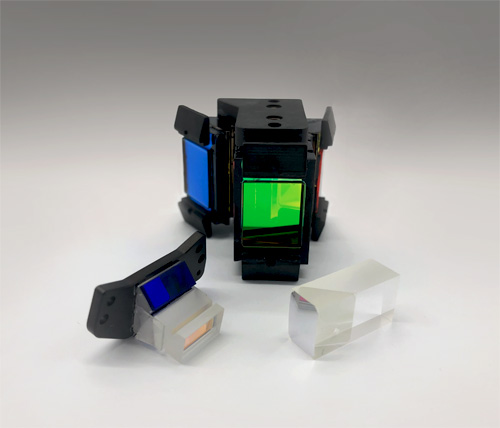- Product
- Technical data
- Resource
Compared to cameras with only one CCD, RGB Prism cameras generally provide superior image quality by using full-frame dichroic filters to better separate the red, green and blue color bands, and better low-light performance. By separating red, green, and blue color ranges with a 1:1 pixel ratio (known as "4:4:4"), three-CCD cameras achieve much better precision than single-CCD cameras.
In contrast, almost all single-CCD cameras use a Bayer filter, using less accurate dye filters in front of each pixel to separate the colors. Because each pixel on a single CCD sensor is covered with its own tiny color filter, a frame is necessary to keep the dye filters from leaking into adjacent pixels. The result is less light absorbed compared to a CCD without a Bayer filter. Typically there is a 2:1 ratio of green and red/blue pixels, producing less color detail.
RGB Prism cameras are more expensive than single-CCD cameras because they use three sensors rather than one, and because they use a beam splitter to drive each of the three CCD chips. Additionally most 3CCD cameras use higher quality but more expensive dichroic filters to separate the color bands.
The practice of cameras using three separate colors for color reproduction dates back to the advent of color photography, when three glass plates covered with photographic emulsion were used beginning in the late nineteenth century.
Now that (C)MOS (MOS = "metal oxide semiconductor") sensors are sufficiently advanced to compete with CCD technology, the catch-all term "three-chip" has arisen to cover all cameras that use beam splitters and three sensors for color reproduction. Previously, CCD sensors were superior to MOS in areas like image noise and sensitivity, and the ability to operate with global shutter.
Prior to CCD technology, color cameras used vacuum tube sensors for both color and monochrome. Because of mechanical tolerances and electrical changes as electronic components aged, 3-tube cameras had to be adjusted for image registration before each use. Each pixel in a CCD imager is fixed, so each of the three CCD elements on a 3CCD camera are registered in the factory, and permanently glued onto the optical block, thus eliminating any need for manual alignment (registration) by the end user.





 Technical support
Technical support lankecms
lankecms